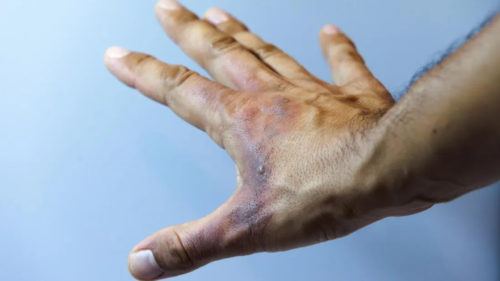From Ashes to Ashes All About Burns

Minor accidents at home, your workplace or any other location may result in burn injuries. The severity of a burn depends on its type; treatment for a burn too depends on its severity and type. Let us first understand the major types of burns based on severity:
Major Types of Burns (based on severity)
- 1st Degree Burns – 1st degree burns are the ones which affect only the epidermis i.e. the outer layer of the skin. Such burns are considered minor in nature; however, they do cause pain and a reddening of the affected part of the skin.
- 2nd Degree Burns – 2nd degree burns are more serious than 1st degree burns. They affect not only the epidermis but the dermis (lower layer of skin) too. A 2nd degree burn injury is marked by pain, redness of the burnt area, swelling, and appearance of blisters. There are two types of 2nd degree burns:
- Superficial partial-thickness burns – These are restricted to the first and second layers of the skin.
- Deep partial-thickness burns – These affect deeper layers of the skin.
- 3rd Degree Burns – A very severe type of burn, 3rd degree burns penetrate through each layer of the skin and even affect the tissues underneath. Because the nerve endings in and around the injured area get completely destroyed, 3rd degree burns are often painless. The injured area starts to appear white or even charred black.
- 4th Degree Burns – These burns go beyond the skin to injure muscles, tendons, nerves, blood vessels and even bones. 4th degree burns will always require immediate medical attention.
What Could Cause a Burn
There could be many causes of burns and these could be as common as intense sunlight or as specific as exposure to certain chemicals. Open fire or flames(dry heat), steam or hot fluids(wet heat), hot surfaces, electrical shocks and even extreme friction against an abrasive surface – all of these can inflict a burn injury.
Symptoms To Identify a Burn
The symptoms of a burn injury vary with the type and cause of the burn. Following are some symptoms which usually accompany a burn injury:
- Red Skin – Reddening of skin is characteristic of 1st and 2nd degree burns.
- Pain – Pain marks 1st and 2nd degree burns. 3rd degree burns may not cause the sensation of pain.
- Blisters – Blistered skin makes the injury likely to be a 2nd degree burn.
- State of Shock – When in shock, a person may feel weakness, a drop in alertness; his/her lips and fingernails might turn blue. It is highly likely to be induced by a 3rd degree burn.
- Swelling – Swelling of the affected area usually indicates 1st or 2nd degree burns.
- White or Charred Skin – Whitening of skin or even a charred black appearance is typical of a 3rd degree burn.
It is often a difficult task to diagnose an electrical burn. Such burns tend to cause drastic injury beneath the skin while leaving the outer skin relatively unaffected.
Treating a Burn
Type and cause of a burn will determine, to a large extent, how it is to be treated. Infection is a concern with all burns. We should be careful about signs of infection when a burn is in the process of healing. Chemical burns may require specific treatment and should be treated by a medical expert.
- 1st Degree Burns – Minor burns or 1st degree burns can be treated most often with antibiotic ointments or even aloe vera gel. An important first aid measure for a minor burn is to place the affected area under cold running water for some time.
- 2nd Degree Burns – Second-degree burns can also be treated with antibiotic creams; however, consult a doctor when the symptoms of a 2nd degree burn become apparent. As first aid, place the affected area under cold water at a tepid flow. Sometimes, in an infection prone environment, the burn will need to be covered. Use a plastic film to cover the wound, instead of cloth, to avoid irritation and pain.
- 3rd Degree Burns – The treatment of a 3rd degree burn is not possible at home and requires medical attention. Doctors may need to perform a skin grafting procedure involving the use of synthetic skin. More severe burns, which are spread over significant parts of the body, are likely to require intensive treatment such as intravenous (IV) antibiotics to prevent infection or IV fluids to make up for fluid loss due to the burn injury.
Prevention…Is Better Than Cure
Most of the time, burn injuries are caused by carelessness or lack of alertness. They can be avoided or prevented simply by being vigilant when in situations of possible hazard. Though there are various treatments available for burns, it is always better to stick to the wise old saying – prevention is better than cure.
Disclaimer: This content including advice provides generic information only. It is in no way a substitute for qualified medical opinion. Always consult a specialist or your own doctor for more information.
